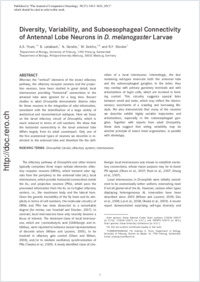Diversity, variability, and suboesophageal connectivity of antennal lobe neurons in D. melanogaster larvae
- Thum, Andreas S. Department of Biology, University of Fribourg, Switzerland
- Leisibach, Basil Department of Biology, University of Fribourg, Switzerland
- Gendre, Nanaë Department of Biology, University of Fribourg, Switzerland
- Selcho, Mareike Department of Biology, University of Fribourg, Switzerland - Department of Biology, Philipps-University Marburg, Germany
- Stocker, Reinhard F. Department of Biology, University of Fribourg, Switzerland
-
27.09.2011
Published in:
- The Journal of Comparative Neurology. - 2011, vol. 59, no. 17, p. 3415–3432
English
Whereas the “vertical” elements of the insect olfactory pathway, the olfactory receptor neurons and the projection neurons, have been studied in great detail, local interneurons providing “horizontal” connections in the antennal lobe were ignored for a long time. Recent studies in adult Drosophila demonstrate diverse roles for these neurons in the integration of odor information, consistent with the identification of a large variety of anatomical and neurochemical subtypes. Here we focus on the larval olfactory circuit of Drosophila, which is much reduced in terms of cell numbers. We show that the horizontal connectivity in the larval antennal lobe differs largely from its adult counterpart. Only one of the five anatomical types of neurons we describe is restricted to the antennal lobe and therefore fits the definition of a local interneuron. Interestingly, the four remaining subtypes innervate both the antennal lobe and the suboesophageal ganglion. In the latter, they may overlap with primary gustatory terminals and with arborizations of hugin cells, which are involved in feeding control. This circuitry suggests special links between smell and taste, which may reflect the chemosensory constraints of a crawling and burrowing lifestyle. We also demonstrate that many of the neurons we describe exhibit highly variable trajectories and arborizations, especially in the suboesophageal ganglion. Together with reports from adult Drosophila, these data suggest that wiring variability may be another principle of insect brain organization, in parallel with stereotypy.
- Faculty
- Faculté des sciences et de médecine
- Department
- Département de Biologie
- Language
-
- English
- Classification
- Biological sciences
- License
- License undefined
- Identifiers
-
- RERO DOC 27915
- DOI 10.1002/cne.22713
- Persistent URL
- https://folia.unifr.ch/unifr/documents/302265
Statistics
Document views: 100
File downloads:
- sto_dvs.pdf: 181
